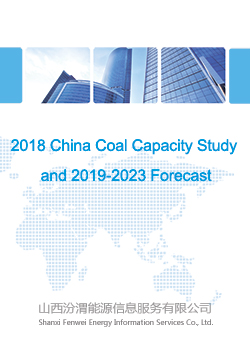
Cycle of publication: Annual
Date of completion: Dec, 2018
Online Self-purchase
Since supply-side reforms started in 2016, remarkable achievements have been made. By 2018-end, 670Mt of backward capacity will have been eliminated totally, reversing the oversupply in 2012-2015. Coal prices rebounded rapidly and profitability of coal producers have been improving. After three years' execution, the exit of backward capacity and release of advanced capacity are playing a key role in promoting the development of the coal market.
Fenwei Energy is timely releasing "2018 China Coal Capacity Study and 2019-2023 Forecast", to review coal capacity in China and by province/type, and forecast the changes of supply capacity in 2019-2023, based on its own coal capacity database. The report incorporates abundant data, figures and technical parameters, able to provide a valuable reference for you to master capacity status quo and future development of China's coal industry.
1. 2016-2017 Coal Industry Supply-side Reform Review
1.1 Policy evolution - from concentrated de-capacity to advanced capacity construction and capacity structure optimization
1.2 Completion of de-capacity targets
1.2.1 Capacity withdrawal in China
1.2.2 Capacity withdrawal by province/by coal type (thermal coal, coking coal)
1.2.3 Coal capacity composition by 2017-end (by province, by type)
1.3 Construction of advanced capacity and capacity addition
1.4 Changes in coal industry brought by supply-side reforms
1.4.1 Mine scale
1.4.2 Capacity structure
1.4.3 Coal output
1.4.4 Corporate profitability
1.4.5 Coal import & export
1.4.6 Safety and environmental protection
2. 2018 Coal Supply-side Reform Policy and Execution Results
2.1 Policy requirements
2.1.1 Policy contents - requirements on de-capacity and capacity replacement
2.1.2 De-capacity targets by province
2.2 Completion ofde-capacity targets
2.2.1 Capacity withdrawal in China
2.2.2 Capacity withdrawal by province/by type (thermal coal, coking coal)
2.3 Construction of advanced capacity and capacity addition
3. China Coal Capacity Status Quo by 2018-end
3.1 Total capacity
3.1.1 In China
3.1.2 Byprovince
3.2.1 Capacity by province of operating, built-up, under-construction and suspending mines
3.2.2 Total thermal coal capacity
3.2.3 Effective thermal coal capacity
3.3 Coking coal capacity
3.3.1 Capacity by province of operating, built-up, under-construction and suspending mines
3.3.2 Total coking coal capacity
3.3.3 Effective coking coal capacity
4. 2019-2023 Coal Capacity Forecast
4.1 Coal industry supply-side reform policy developmenttrend
4.2 De-capacity target forecast
4.2.1 In China
4.2.2 By province
4.3 Construction of advanced capacity and operation of newly-added capacity forecast
4.4 Thermal coal capacity forecast
4.4.1 Capacity withdrawal by province
4.4.2 Capacityby province of operating, built-up, under-construction and suspending mines
4.4.3 Total thermal coal capacity forecast
4.4.4 Effective thermal coal capacity forecast by province
4.5 Coking coal capacity forecast
4.5.1 Capacity withdrawal by province
4.5.2 Capacity by province of operating, built-up, under-construction and suspending mines
4.5.3 Total coking coal capacity forecast
4.5.4 Effective coking coal capacity forecastby province
4.6 Total coal capacity forecast
4.6.1 Coal capacity by province of operating, built-up, under-construction and suspending mines
4.6.2 Total effective capacity forecast
4.7 China coal capacity development trend analysis
5. Conclusions
Hot-sale Products